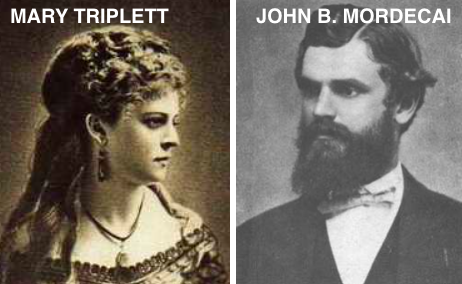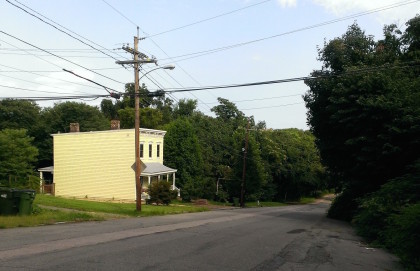RECENT COMMENTS

The Church Hill Dueling Grounds
Although the most famous duel in America, between Aaron Burr and Alexander Hamilton, occurred in New Jersey, the vast majority of duels occurred in the South. Duels had been long frowned upon in the North, and Hamilton’s death at Burr’s hands sped up the demise of dueling north of the Mason-Dixon Line.
In the South, dueling was a long-established tradition deeply entrenched in an elaborate code of honor practiced by Southern men. The extremely complicated rules and customs governing the tradition of dueling had been outlined in the 18th century in a book titled Code Duello. Most Southern cities had dueling grounds, and in Richmond, there were at least two, both in Church Hill.
On April 10, 1801, a twenty-year-old man named Gill Armistead Selden, a married father of two, was shot and killed in duel with Skelton Jones. Dueling was so prevalent that Skelton Jones, his brother Meriwether Jones, and Selden’s brother Joseph were all later killed in duels.
— ∮∮∮ —

According to an 1848 map, the dueling ground ran the entire length of the east side of 30th Street, between Franklin and Grace streets.
— ∮∮∮ —
The place of this duel has been referred to by contemporary writings as the Bloody Run or Chimborazo Heights dueling ground. According to an 1848 map, this dueling ground where Selden lost his life was still in use, and ran the entire length of the east side of 30th Street, between Franklin and Grace streets. Because 30th Street no longer intersects either of these streets, the heavily-wooded former dueling ground is only visible from an isolated part of East Franklin Street, east of 29th Street.
Richmond’s most famous duel occurred in Church Hill as well. On May 9, 1873, Page McCarty shot and killed John Brooke Mordecai in the Confederate section of Oakwood Cemetery, which had frequently been used for duels.
Former friends, the two became enemies when a popular Richmond girl, Mary Triplett, dropped her interest in McCarty in favor of Mordecai. Mary publicly snubbed McCarty at a ball, and McCarty responded by publishing a slightly inappropriate poem about Mary in a newspaper.
Mordecai challenged McCarty, who shot Mordecai in the stomach. He lingered for several days before dying. After the duel, McCarty, who was shot in the hip, never married and shunned society. Mary Triplett later married Phillip Haxall, but died young.
Dueling began to decline in Richmond, but did not end completely until Joseph Bryan, challenged to a duel in the 1890’s, reported his challenger to the police and called him “absurd.”






LOL at the last paragraph. This is an intriguing bit of RVA history, thanks!
Seems to me a lot of dueling is still going on in the East End, without the elaborate code of honor.
Sad irony in using Oakwood as a dueling ground (as if there weren’t enough bullets in the ground). It’s interesting though, and I’d love to see the poem about Mary Triplett if you ever find it.
Great write-up!
A contemporary dueling ground could be just the place to settle some of Church Hills more contentious arguments. From petanque courts, to Captain Buzzy’s to Pear St. and the Shockoe stadium, officially sanctioned duels could really streamline a lot of the difficult decisions around here. Perhaps the petanque courts could double as a dueling ground every 3rd Saturday of the month. Winnings from wagers on the duels could go to pay for any number of neighborhood projects. 😉
Katherine Jester – The poem read:
“When Mary’s queenly form I press
In Strauss’ latest waltz,
I would as well her lips caress
Although those lips be false.
For still with fire love tips his dart,
And kindles up anew
The flames which once consumed my heart
When those dear lips were true.
Of form so fair, of faith so faint,
If truth were only in her;
Though she’d be then the sweetest saint,
I’d still feel like a sinner.”
Bravo!!
Thank you for that, and for the great article. I’ve enjoyed your contributions very much and look forward to seeing what else you come up with.
Hello everyone, don’t forget to check out my monthly articles in the CHA Newsletters.
The article for October will be about Evergreen and associated surrounding cemeteries. It will help segue into a project I will be embarking on to help right a wrong with the deplorable condition it is in. I am asking for help from anyone with any early history of the cemetery anyone can provide. I asked John M. here but he said he was too busy… guess all of these history posts is taking up too much of his time?
In a recent post of mine I did mention that one of the first owners of the property was Reuben Blakey. This was eventually named Blakey’s Mill and was a well known area for several reason, one being the duel. But I am afraid if John is trying to locate the site for the William Page McCarty (1839-1900) / John Brooke Mordecai (1839-1873) duel on 30th Street this is incorrect. The 1873 papers elude to a different area. One mentioned it happening at a glade near the railroad tracks at Blakey’s Mill and another says this:
” THE FIELD OF HONOR – Friday afternoon late, attracting no attention beyond that aroused by the ordinary sight-seers that are continually driving about our city environs. The place selected was a sequestered vale southeast of Oakwood Cemetery, beyond Blakey’s Mill, not far from the line of the Richmond and York River (or Richmond and Chesapeake) railroad. The weapons were Colt’s navy revolvers. carrying army balls, and the distance ten paces.”
Looking at the 1865 map this would be currently in an area across from Montrose Heights in a triangle bordered by East Richmond Road, Jennie Scher Rd ad the railroad tracks in the general vicinity of a water tank which is off of the 4000 block of E. Richmond Rd.
Since the area was all farm and woods then, on the map the only other clearing SE of Oakwood beyond Blakey’s Mill is across the track in what is now Montrose Heights. I would think the former mentioned is a closer fit.
Eric – the Selden-Jones duel was the one that took place on 30th Street. The McCarty-Mordecai duel, according to contemporary sources, took place in the Confederate section of Oakwood.
Tricia, the Mordecai-McCarty duel did not happen at the Confederate cemetery but all of the newspaper accounts from when it actually happened in 1873 says it was by the railroad tracks as in the actual excerpt I posted above. 🙂
Blakey’s Mill ran a lot further past Oakwood – almost a half size of Oakwood more running down to the railroad track. The other account mentioned a glade next to the tracks.
Looking at the 1865 (says 1865 on the map but people say it is 1867) map again it shows a road that runs along the Blakey property line and under the railroad racks in that vicinity I was speaking about. The article says southeast “of” Oakwood, not in or part of, and beyond Blakey which this is, barely and ordinary sightseers could drive down that road which runs perpendicular off a stretch that is now called E. Richmond Rd. It originally only ran the length of Oakwood then dropped towards the railroad tracks on a smaller road along Stony Run Creek.
The land was heavily wooded in most places but the spot I cited seems to be a clearing “glade or vale” in the right vicinity per descriptions.